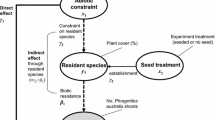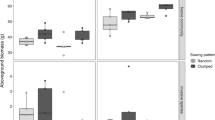Abstract
Although invasion risk is expected to increase with propagule pressure (PP), it is unclear whether PP-invasibility relationships follow an asymptotic or some other non-linear form and whether such relationships vary with underlying environmental conditions. Using manipulations of PP, soil fertility and disturbance, we tested how each influence PP-invasibility relationships for Lespedeza cuneata in a Kansas grassland and use recruitment curve models to determine how safe sites may contribute to plant invasions. After three growing seasons, we found that the PP-invasibility relationships best fit an asymptotic model of invasion reflecting a combination of density-independent and density-dependent processes and that seeds were aggregated within the plant community despite efforts to uniformly sow seeds. Consistent with some models, community invasibility decreased with enhanced soil fertility or reduced levels of disturbance in response to changes in the fraction of safe sites. Our results illustrate that disturbance and soil fertility can be a useful organizing principle for predicting community invasibility, asymptotic models are a reasonable starting point for modeling invasion, and new modeling techniques—coupled with classic experimental approaches—can enhance our understanding of the invasion process.




Similar content being viewed by others

References
Bakker ES, Olff H (2003) Impact of different-sized herbivores on recruitment opportunities for subordinate herbs in grasslands. J Veg Sci 14:465–474
Bolker BM (2008) Ecological models and data in R. Princeton University Press, Princeton
Brandon AL, Gibson DJ, Middleton BA (2004) Mechanisms for dominance in an early successional old field by the invasive non-native Lespedeza cuneata (Dum. Cours.) G. Don. Biol Inv 6:483–493
Brännström A, Sumpter DJT (2005) The role of competition and clustering in population dynamics. Proc R Soc B-Biol Sci 272:2065–2072
Burhnam KP, Anderson DR (2002) Model selection and multi-model inference. Springer, Berlin
Callaway RM, Ridenour WM (2004) Novel weapons: invasive success and the evolution of increased competitive ability. Front Ecol Environ 2:436–443
Clark CJ, Poulsen JR, Levey DJ, Osenberg CW (2007) Are plant populations seed limited? A critique and meta-analysis of seed addition experiments. Am Nat 170:128–142
D’Antonio CM (1993) Mechanisms controlling invasion of coastal plant communities by the alien succulent Carpobrotus edulis. Ecology 74:83–95
Davis MA, Grime JP, Thompson K (2000) Fluctuating resources in plant communities: a general theory of invasibility. J Ecol 88:528–534
Dickson TL, Foster BL (2008) The relative importance of the species pool, productivity and disturbance in regulating grassland plant species richness: a field experiment. J Ecol 96:937–946
Drake JM, Lodge DM (2006) Allee effects, propagule pressure and the probability of establishment: risk analysis for biological invasions. Biol Inv 8:365–375
Dudley DM, Fick WH (2003) Effects of Sericea lespedeza residues on selected tallgrass prairie grasses. Trans Kans Acad Sci 106:166–170
Duggin JA, Gentle CB (1998) Experimental evidence on the importance of disturbance intensity for invasion of Lantana camara L. in dry rainforest-open forest ecotones in north-eastern NSW, Australia. For Ecol Manage 109:279–292
Duncan RP, Diez JM, Sullivan JJ, Wangen S, Miller AL (2009) Safe sites, seed supply, and the recruitment function in plant populations. Ecology 90:2129–2138
Eager EA, Rebarber R, Tenhumberg B (2012) Choice of density-dependent seedling recruitment function affects predicted transient dynamics: a case study with Platte thistle. Theor Ecol 5:387–401
Eckberg JO, Tenhumberg B, Louda SM (2012) Insect herbivory and propagule pressure influence Cirsium vulgare invasiveness across the landscape. Ecology 93:1787–1794
Eschtruth AK, Battles JJ (2009) Assessing the relative importance of disturbance, herbivory, diversity, and propagule pressure in exotic plant invasion. Ecol Monogr 79:265–280
Eschtruth AK, Battles JJ (2011) The importance of quantifying propagule pressure to understand invasion: an examination of riparian forest invasibility. Ecology 92:1314–1322
Fowler NL (1988) What is a safe site? Neighbor, litter, germination date, and patch effects. Ecology 69:947–961
Harper JL, Clatworthy JN, McNaughton IH, Sagar GR (1961) The evolution and ecology of closely related species living in the same area. Evolution 15:209–227
Houseman GR, Gross KL (2006) Does ecological filtering across a productivity gradient explain variation in species pool-richness relationships? Oikos 115:148–154
Houseman GR, Gross KL (2011) Linking grassland plant diversity to species pools, sorting and plant traits. J Ecol 99:464–472
Huston MA (1994) Biological diversity: the coexistence of species on changing landscapes. Cambridge University Press, Cambridge
Huston MA (2004) Management strategies for plant invasions: manipulating productivity, disturbance, and competition. Div Distrib 10:167–178
Lake JC, Leishman MR (2004) Invasion success of exotic in natural ecosystems: the role of disturbance, plant attributes and freedom from herbivores. Biol Cons 117:215–226
Lambrinos JG (2002) The variable invasive success of Cortaderia species in a complex landscape. Ecology 83:518–529
Langdale GW, Giddens JE (1967) Phytotoxic phenolic compounds in sericea lespedeza residues. Agron J 59:581
Lockwood JL, Cassey P, Blackburn T (2005) The role of propagule pressure in explaining species invasions. Trends Ecol Evol 20:223–228
Lockwood JL, Cassey P, Blackburn TM (2009) The more you introduce the more you get: the role of colonization pressure and propagule pressure in invasion ecology. Div Distrib 15:904–910
Mitchell CE et al (2006) Biotic interactions and plant invasions. Ecol Lett 9:726–740
Nicholson AJ (1954) An outline of the dynamics of animal populations. Aust J Zool 2:9–65
Poulsen JR, Osenberg CW, Clark CJ, Levey DJ, Bolker BM (2007) Plants as reef fish: fitting the functional form of seedling recruitment. Am Nat 170:167–183
Purves DW, Law R (2002) Fine-scale spatial structure in a grassland community: quantifying the plant’s-eye view. J Ecol 90:121–129
Renne IJ, Tracy BF, Colonna IA (2006) Shifts in grassland invasibility: effects of soil resources, disturbance, composition, and invader size. Ecology 87:2264–2277
Sanders NJ et al (2007) Insects mediate the effects of propagule supply and resource availability on a plant invasion. Ecology 88:2383–2391
Siemann E, Rogers WE, Grace JB (2007) Effects of nutrient loading and extreme rainfall events on coastal tallgrass prairies: invasion intensity, vegetation responses, and carbon and nitrogen distribution. Glob Change Biol 13:2184–2192
Silliman S, Maccarone AD (2005) Distribution, infestation, and habits of Sericea lespedeza (Lespedeza cuneata) in Cowley County, Kansas. Trans Kans Acad Sci 108:83–92
Simberloff D (2009) The role of propagule pressure in biological invasions. Annu Rev Ecol Evol Syst 40:81–102
Tanentzap AJ, Bazely DR (2009) Propagule pressure and resource availability determine plant community invasibility in a temperate forest understorey. Oikos 118:300–308
Taylor CM, Hastings A (2005) Allee effects in biological invasions. Ecol Lett 8:895–908
Thompson K, Hodgson JG, Grime JP, Burke MJW (2001) Plant traits and temporal scale: evidence from a 5-year invasion experiment using native species. J Ecol 89:1054–1060
Vitousek PM et al (2002) Towards an ecological understanding of biological nitrogen fixation. Biogeochemistry 57:1–45
Von Holle B, Simberloff D (2005) Ecological resistance to biological invasion overwhelmed by propagule pressure. Ecology 86:3212–3218
Williamson M (1996) Biological invasions. Chapman & Hall, London
Wiser SK, Allen RB, Clinton PW, Platt KH (1998) Community structure and forest invasion by an exotic herb over 23 years. Ecology 79:2071–2081
Wong BM, Houseman GR, Hinman SE, Foster BL (2012) Targeting vulnerable life-stages of Sericea lespedeza (Lespedeza cuneata) with prescribed burns. Inv Plant Sci Manage 5:487–493
Woods TM, Hartnett DC, Ferguson CJ (2009) High propagule production and reproductive fitness homeostasis contribute to the invasiveness of Lespedeza cuneata (Fabaceae). Biol Inv 11:1913–1927
Acknowledgments
The authors are grateful to the University of Kansas Field Station for logistical support. This project was supported by National Research Initiative, Cooperative State Research, Education, and Extension Service, US Department of Agriculture award 2006-35320-17239 to G. R. H. and NSF DEB 0953766 to C. E. B.
Author information
Authors and Affiliations
Corresponding author
Additional information
Communicated by Melinda Smith.
Rights and permissions
About this article
Cite this article
Houseman, G.R., Foster, B.L. & Brassil, C.E. Propagule pressure-invasibility relationships: testing the influence of soil fertility and disturbance with Lespedeza cuneata . Oecologia 174, 511–520 (2014). https://doi.org/10.1007/s00442-013-2781-x
Received:
Accepted:
Published:
Issue Date:
DOI: https://doi.org/10.1007/s00442-013-2781-x



